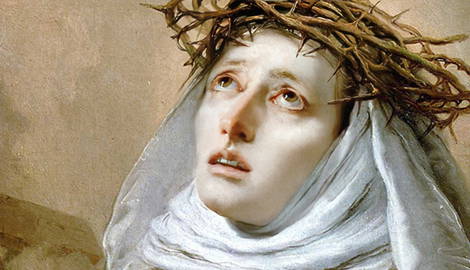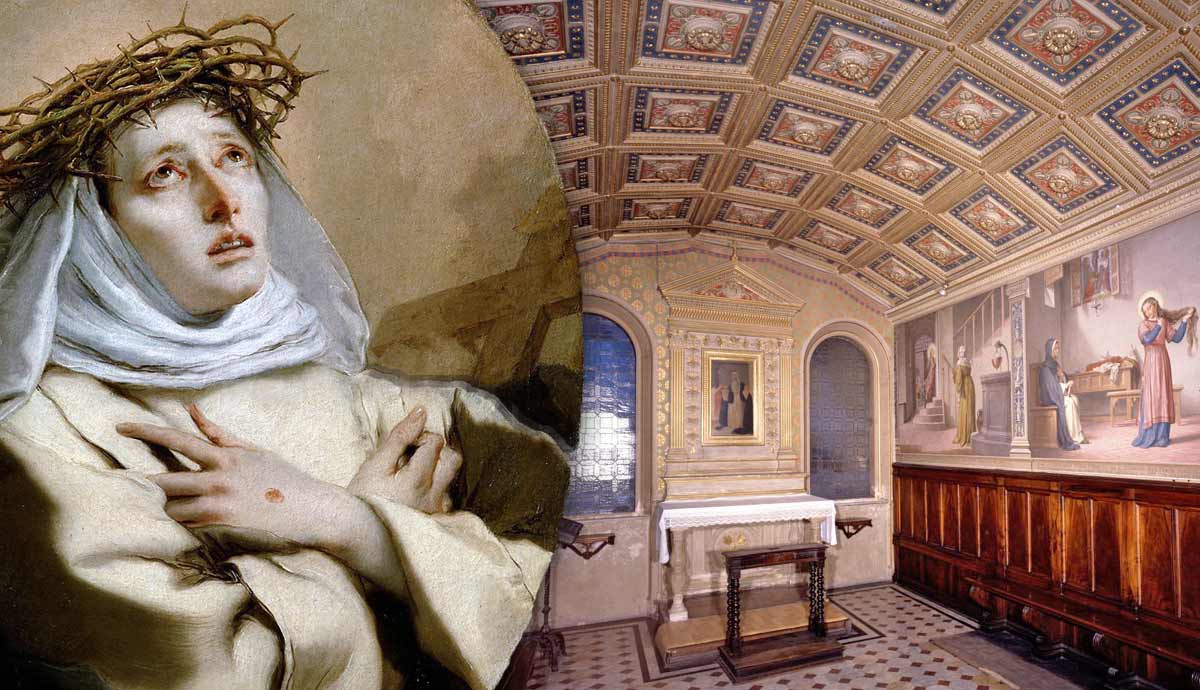
Margery Kempe is remembered as one of history’s most outrageous figures. Her extreme form of devotional worship—known as mysticism—has polarized historians and theologians alike. Some find her public sobbing in an all-white wardrobe rather sublime. Some find it camp. Regardless, her vital text, The Book of Margery Kempe, has gone down in history as the first autobiography in English. In it, she spares little to the imagination of intimate visions of Christ or her desire to be hauled on a wheel and have mud thrown over her.
Who Were Medieval Mystics Like Margery Kempe?

Despite the popular image of the medieval woman as meek and subservient, medieval women played a significant role in the church. Across Europe, many women received visions and callings interpreted as divine. These women are known today as mystics. They often practiced spectacular and extreme forms of worship, raising as many eyebrows as they do today.
Catherine of Siena (1347-1380) spent most of her life healing the sick, which often meant eating their scabs. Later in her life, she subsisted entirely off the scabs of the ill and the eucharist. As recorded in a letter, she wore a ring of Christ’s foreskin. Neither how she got this nor what it looked like are available to us today. Eventually, she died of starvation.

Margery Kempe was not the only mystic in late medieval England. The theologian and hermit Richard Rolle (1300-1349) was her contemporary, who wandered around the hills of Yorkshire in a robe fashioned from his sister’s clothing. She was without a doubt, however, the most spectacular. She was also the only laywoman.
At this time, most women who devoted themselves to the spiritual life were known as anchoresses. An anchoress was a woman who agreed to forgo worldly life and be locked away eternally in an enclosed cell. These cells were typically attached to chapels. Many women chose to become anchoresses, and there is even a surviving book called the Ancrene Wisse instructing their education and lifestyle. The mystic Julian of Norwich (1343-1416) is the most well-known, who recorded her visions in her Revelations of Divine Love. Julian and Kempe knew one another, and Kempe even paid her a visit.
Writing England’s First Autobiography

Kempe is spectacular for several reasons. She was a laywoman from a mercantile family and is remembered as one of the most controversial and provocative mystics of her time. She was also wholly illiterate and yet wrote the first English autobiography.
What we know of Kempe’s life comes from her book. In short, we’re taking her word for it. Kempe wrote before the invention of the Gutenberg printing presses in Europe, which were the first of their kind. Prior to this, Kempe and her contemporaries typically wrote on vellum. Vellum is an animal skin that is treated and written on by hand. This was a costly and time-consuming process, meaning books were seldom re-produced unless they were particularly important or popular. Even Chaucer’s incredibly beloved Canterbury Tales have barely survived in manuscript form, and none authored by Chaucer himself.
The only surviving manuscript of Kempe’s work was discovered in 1934. Given Kempe was illiterate, she dictated her work to three scribes. These scribes would have authored the work for her. Each time a new scribe began, however, they could not read what the previous had written. Medieval scribes were not neutral copyists, and when copying other works, they often made mistakes or even intentional edits. One (a priest) even refrained from working with Kempe initially for fear of her terrible reputation. Given this is the only manuscript that scholars have, it is difficult to know if or what role the scribe played in composing the text – whether he would have censored or modified it.
However, it is an incredibly frank text. It begins with an account of her first pregnancy until her later life. From describing an assault at the hands of her husband to having her fellow pilgrims cut up her gown on pilgrimage, Kempe’s book provides the reader with an insight into the tumults and banalities of medieval life that is second to none.
Leaving Her Husband and Marrying Christ

After the birth of her first child, Kempe suddenly fell out of love with her husband. She recalls how she would have rather drank the “muck in the gutter” than “consent to any fleshly communing” (see: sex).
Many women who became known as mystics had tumultuous and difficult relationships with sex. Catherine of Siena was said to have cut her hair and starved herself when met with the prospect of an arranged marriage. Her parents, who arranged the marriage, called the whole thing off.
According to Kempe, a male friend confessed his desire for her. He told her that he was desperate to sleep with her and would force her if not. She left him quickly but recalled being unable to stop thinking about him, even during church. When she later agreed to sleep with him, he rebuked her. He would not sleep with her “for all the gold in this world” and would “rather be hewn [chopped up] as small as flesh for the pot.” He was apparently testing her.
Kempe’s narrative is not only an interesting insight into ordinary medieval life but also daily medieval speech (“I wouldn’t sleep with you for all the gold in the world!”). Yet Kempe’s divine, extraordinary experience is no less intriguing.
Like many female mystics, she envisioned Christ as her husband. Her visions of Christ were deeply intimate, and such visions that may strike us today as bizarre were not so uncommon for those of Kempe’s time. For instance, Kempe’s contemporary Julian of Norwich had visions of Christ as a mother who birthed us through his wounds.
Tensions With Pilgrims

Like many wealthy medieval people, Kempe went on pilgrimage during her lifetime. Pilgrimages took medieval people to sacred sites across Europe and the Middle East, where they traveled in groups. Since large groups of people would travel together for long periods, medieval pilgrimages were deeply social events. Chaucer’s famous The Canterbury Tales details the sorts of stories that would be exchanged during such journeys.
The problem was that Kempe was hardly a crowd-pleaser. She spoke frequently about God and often to the point of bursting into tears. Despite pilgrimages supposedly being holy journeys, for many, these were also simply a holiday. Kempe’s fellow travelers quickly found all her talk about God rather tedious. As Kempe records in her book, those whom she spoke to about God would say to her:
“Why speak ye so of the mirth [joy] that is in Heaven? Ye know it not, and ye have not been there any more than we.”
It seems as if Kempe’s fellow pilgrims just wanted a break. Her fits of sobbing and rambling about the Lord became so loathsome to them that they decided to cut up her dress. Once her clothing had been cut up, she recalls, they forced her to wear a fool’s garment. When this did not suffice to stop her, they simply left her. Stealing her money and forcefully removing her maid, the other pilgrims abandoned Kempe once they reached Constance.
The Woman Who Couldn’t Stop Crying

Kempe eventually reached Jerusalem, where she and other pilgrims were taken to see the crucifix upon which Christ had supposedly died. Medieval pilgrimages often smacked a little of divine tourism – pilgrims could gawk at sacred sites or even purchase a holy artifact or two. No amount of money, however, could purchase the sight Kempe was to make of herself.
When Kempe saw the site at which Christ was said to be killed, she recalls how she saw a vision of Christ himself being crucified. Suddenly, she fell to the ground – where she spread out her arms and screamed. Onlookers were mortified. This would be the first instance of her screaming, but it would not be the last. She records in her book that:
“As soon as she perceived that she would cry, she would keep it in as much as she might that the people should not hear it to their annoyance. For some said that a wicked spirit vexed her, some said it was a sickness, some said she had drunk too much wine.”
Yet cry she would, even to the point of growing as “blue as lead.” When she returned to England, her crying would gain the ire of other townspeople. While traveling England in her all-white wardrobe, she spent much time in and out of prison and finally tried for heresy. This was not least because she would spend many Sundays screaming and crying through Mass.
In modern text translations, translators often translate the Middle English verb “cry” as our contemporary “cry.” That is to say, to shed tears. Yet the middle English “cry” comes much closer to screaming. Where the Middle English “weep” is akin to our modern “cry”, the middle English “cry” is like a desperate and frantic screeching. Margery Kempe was not merely softly sobbing. She was constantly screaming.
Margery Kempe: Madness or Mysticism?

Kempe’s story has been interpreted variously by historians. Some have argued that Kempe suffered from postpartum psychosis. Symptoms of postpartum psychosis involve delusions and tearfulness. Yet it is important to remember that our understanding of mental illness today is a deeply modern one, which cannot account for the nuance of divine experience as experienced by mystics like Kempe.
Yet others have argued that her extreme form of worship is only one example of what is known as imitatio Christi. This was an embodied form of worship where mystics would imitate the suffering of Christ. Kempe began to roll around in the dirt and scream as she envisioned Christ in Jerusalem because she was becoming one with him. This was the gesture of the eucharist – to become one with Christ. It is perhaps for this reason that Kempe expressed her desire to be laid naked on a wheel, taken from town to town, and have mud thrown over her.
Kempe was not stupid. Despite her flamboyant and polarizing behavior, Kempe was loved by as many as she was hated. Her visions had theological insight. When she saw suffering—be it a boy being hit by his father or a beggar starving—she was reminded of the suffering of Christ. Amid all her outrageous histrionics, Kempe never forgot that the suffering of Christ was not just his own – but a symbol of everyone’s.










